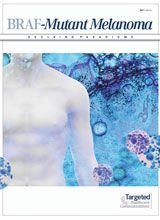Weber Compares BRAF/MEK, Immunotherapy Combos in Melanoma
With 2 different BRAF/MEK combination regimens approved by the FDA, as well as an immunotherapy combination, treatment and sequencing decisions for metastatic BRAF-mutated melanoma can be difficult.
BRAF-mutated melanoma can be difficult, says Jeffrey S. Weber, MD, PhD, deputy director of the Laura and Isaac Perlmutter Cancer Center, codirector of the Melanoma Program, and head of Experimental Therapeutics at NYU Langone Medical Center.
It is still unclear whether BRAF/MEK combinations, such as dabrafenib (Tafinlar) plus trametinib (Mekinist) or vemurafenib (Zelboraf) plus cobimetinib (Cotellic), or immunotherapy combinations, such as nivolumab (Opdivo) and ipilimumab (Yervoy) regimen, should be the standard first-line treatment forBRAF-mutated patients, said Weber.
“I am not taking bets; there are arguments for both sides,” he explained. “But, I do think all of these combinations are not only going to delay progression with these agents, but we are going to cure some of these patients.“
In an interview withTargeted Oncology, Weber discussed recent long-term follow-up data of dabrafenib and trametinib that may shed some light on sequencing questions forBRAF-mutated patients. He also discussed an ongoing randomized trial of a head-to-head comparison of BRAF/MEK inhibitors and immunotherapy as first-line treatment.
Targeted Oncology:How has the role of combination therapies in melanoma evolved in recent years?
Weber: There have been 2 combination therapies approved by the FDA recently for melanoma: dabrafenib plus trametinib and vemurafenib plus cobimetinib, which was approved in 2015.
Back in 2011, there was a revolution that adding a MEK inhibitor to a BRAF inhibitor in patients with metastatic disease not only augmented the efficacy of the treatment, but also clearly decreased the toxicities, particularly with skin toxicities. Over the next several years, combination MEK plus BRAF therapy has become the standard of care for treating patients withBRAF-mutated melanoma.
However, for patients who do not have theBRAFmutation in the tumor, it is inappropriate to use these BRAF drugs. For patients who have the mutation, which occurs in about 40% to 50% of all melanomas, the combination of the BRAF and the MEK drugs can be very effective, with high response rates and long survival. I recently presented data on the long-term follow-up of the original phase II and phase III trials looking at the combination of a MEK inhibitor with a BRAF inhibitor.
What were the most significant findings from the long-term follow-up?
The follow-up research suggests a couple of things. First, dabrafenib and trametinib have been tested over a longer period of time, so we have longer follow-up. Second, there appears to be a plateau on the curve as you get out in timein terms of survival follow-up—for dabrafenib and trametinib.
The “urban legend” was that the BRAF and MEK inhibitors had a high response rate, but almost all of the patients would progress quickly, progression-free survival would be less than 1 year, and most patients would have to go on another therapy or would die of their disease.
That’s not exactly true. There does appear to be a plateau in the curve at about 30% for the patients who receive dabrafenib and trametinib. I am sure it will be virtually identical for vemurafenib and cobimetinib, which have a very similar median survival and 1-year survival track record as dabrafenib and trametinib.
We now have mature follow-up data from both dabrafenib and trametinib and vemurafenib and cobimetinib showing that we have about a 25-month median survival in patients treated upfront with metastatic melanoma that isBRAF-mutated who receive these drugs. That is very impressive.
The interesting data from the longer follow-up of dabrafenib and trametinib showed that there is an obvious association between having a high tumor burden, poor performance status, a high LDH, and not doing well with these drugs.
This means that patients who do best with the combination of BRAF/MEK inhibitors have low disease burden with a normal LDH, few symptoms, etc.
This is very interesting, and not exactly like what we have seen with combination immunotherapies. With the combination of ipilimumab and nivolumab, there was not a strong association between LDHwhich is a surrogate for tumor burden—and outcome. Patients did very well whether they had a high tumor burden or not. With targeted therapy, that is not the case.
Do these findings make it any easier for oncologists todetermine frontline treatment forBRAF-mutated patients with melanoma?
These findings suggest that oncologists probably want to intervene with BRAF and MEK drugs earlier rather than later.
If the BRAF and MEK drugs only work in patients with low disease burden, but the immunotherapy drugs can work with either a low or high disease burden, the argument would be in a mutated patient to first give BRAF/MEK and then immunotherapy if the patient progressed or failed.
The targeted therapy will not work as well if patients are receiving immunotherapy first, then they progress, have high LDH, and high disease burden. The association of patients doing well with targeted therapy with low disease burden bodes well for starting with targeted therapy and using immunotherapy in the second-line setting.
This goes against the current “urban legend” that patients should have immunotherapy upfront whether they areBRAF-mutated orBRAFwild-type because those are the patients who are going to get the long tail on the curve in terms of survival. That may not be true.
Are there trials exploring sequencing of targeted therapies and immunotherapy agents forBRAF-mutated patients?
There is an ongoing randomized phase III trial examining this. One group of patients will get upfront immunotherapy with ipilimumab and nivolumab, and at progression, they will receive BRAF/MEK inhibitors. Other patients in the study will receive upfront dabrafenib and trametinib, and then ipilimumab and nivolumab at progression.
Gasparetto Explains Rationale for Quadruplet Front Line in Transplant-Ineligible Myeloma
February 22nd 2025In a Community Case Forum in partnership with the North Carolina Oncology Association, Cristina Gasparetto, MD, discussed the CEPHEUS, IMROZ, and BENEFIT trials of treatment for transplant-ineligible newly diagnosed multiple myeloma.
Read More
